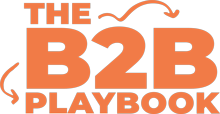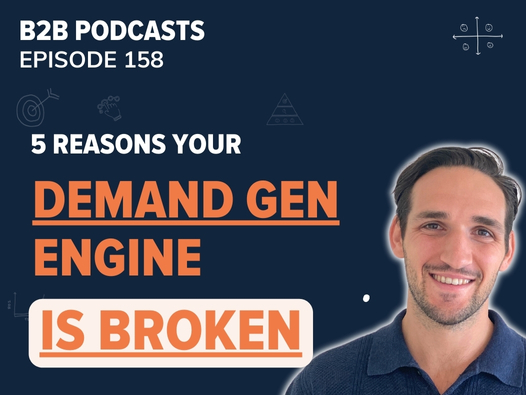Are you frustrated with your demand generation program? You’ve invested time, effort, and resources, but the results just aren’t there. Trust me, you’re not alone. We’ve seen this over and over again with the businesses we work with.
But here’s the thing: demand generation isn’t about quick wins. It’s about building a machine that brings in consistent, high-quality leads, and ultimately, more revenue. After working with a lot of teams to review their Demand Gen Engines and help them build new ones, we’ve seen that most teams make the same critical mistakes, and those mistakes kill their results.
In this article, we’re breaking down the five main reasons why your demand generation program might be falling short – and more importantly – how to fix them. This should give you a roadmap to turning things around and making demand gen start to work for your business.
Let’s dive in.
Listen To The Episode
Watch The Episode
Not Understanding Your Ideal Customer Profile (ICP)
One of the biggest reasons demand generation programs fall flat is because businesses don’t understand their Ideal Customer Profile (ICP) deeply enough. It’s not enough to have a vague idea of who your customers are—you need to know their pain points, motivations, and decision-making process inside out.

I see this mistake all the time—companies trying to go after their entire total addressable market (TAM), casting too wide a net and hoping something sticks. That’s not how it works in B2B marketing. You need to narrow your focus.
Instead of trying to speak to everyone, focus on a small, specific segment that’s the best fit for your business. We suggest you run 80/20 analysis on your business to identify who your top customers are. This identifies your top performing segments, determined by factors that are most important to your business at this time. For example, this may be revenue, profit, serviceability, potential for growth etc.
Once you’ve identified who your best customers are, you need to understand the problems they prioritize and how to lead them to the conclusion that your solution is the best fit.
“Demand generation requires us as a business to convince the market that they need to prioritize the problem you help solve, and that you are the perfect fit to solve it”.
George Coudounaris – The B2B Playbook
Without this level of clarity, your demand gen efforts won’t connect with the right people, and you’ll struggle to generate meaningful results. A great way to get this clarity is to interview your best-fit customers. To do this, find five to eight customers that will talk to you to understand everything you need to know about that segment. This qualitative insight will give you so much more depth and understanding than any generic survey ever could.
The bottom line? Spend the time getting to know your ideal customers—really know them. Talk to them, understand their journey, and shape your demand generation efforts around their needs. When you deeply understand your ICP, you’ll start seeing demand generation work the way it’s supposed to.
Lack of Subject Matter Experts
One of the quickest ways to kill trust with your audience is by creating content that doesn’t come from real experts. In B2B, trust is everything. Without it, your prospects are never going to believe that you truly understand their problems, let alone that you have the best solution.
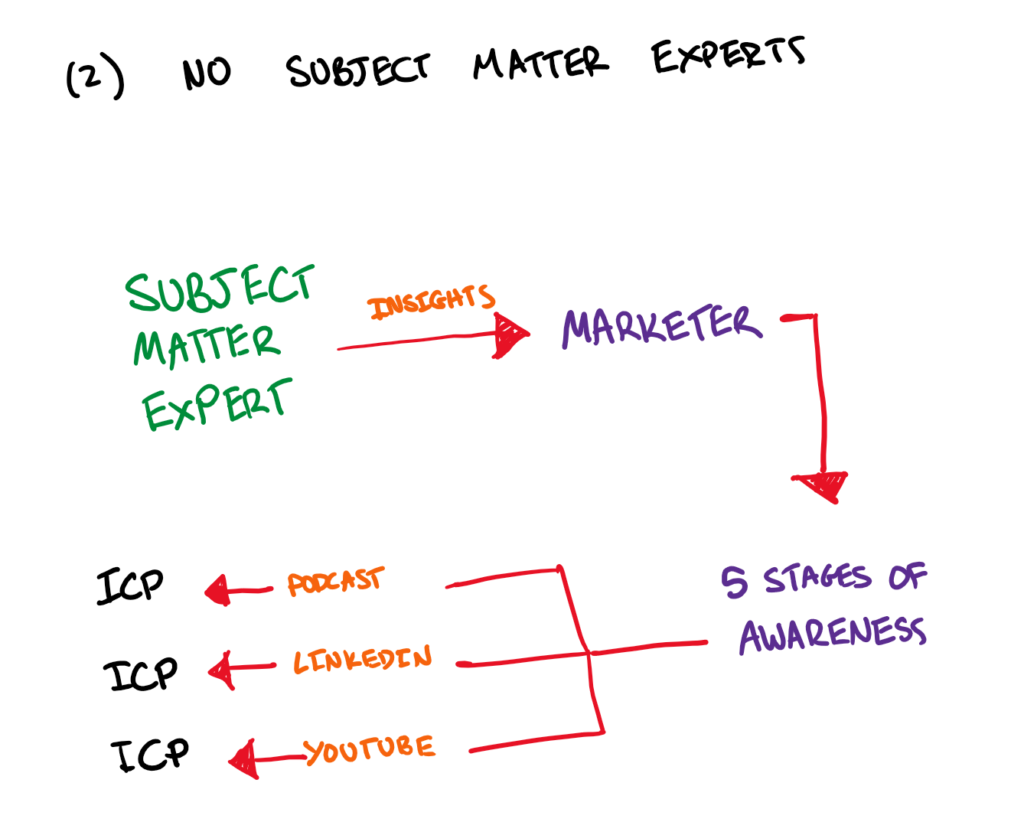
Think about it this way: If you’re selling a product to engineers, and your content is written by someone who doesn’t really understand what engineers do, it’s not going to land. If your content feels disconnected from the realities of your audience, they’ll see right through it. And when that happens, you’ve just lost any chance of building a relationship.
I’ve seen businesses make this mistake all the time. They create content by pulling together the top 10 search results from Google, thinking that’s good enough. But if your eBook is just an amalgamation of what you found as the top 10 search results on Google… that can actually be quite damaging to your brand. It’s not just lazy—it’s risky. If your content feels generic or surface-level, it damages your credibility. And once that trust is broken, it’s tough to rebuild.
Your content needs to build a relationship of trust from the very first touchpoint. That’s why it’s so important to involve subject matter experts from the start. They’re the ones who truly understand your audience’s world, and their insights will elevate your content from forgettable to valuable.
Of course, I get it—working with subject matter experts isn’t always easy. They’re busy, and you don’t want to waste their time. But the key thing is to be really organized, and facilitate that knowledge being extracted from them. It’s your job to make the process as seamless as possible. Get them involved in a structured way, extract their insights efficiently, and then repurpose that content across multiple channels.
Inconsistent Systems and Processes
In B2B marketing, consistency is everything. You need to stay top of mind with your audience, so when they finally come ‘in-market’ and are ready to buy, you’re top of their list. But staying consistent is hard when you don’t have the right systems in place.
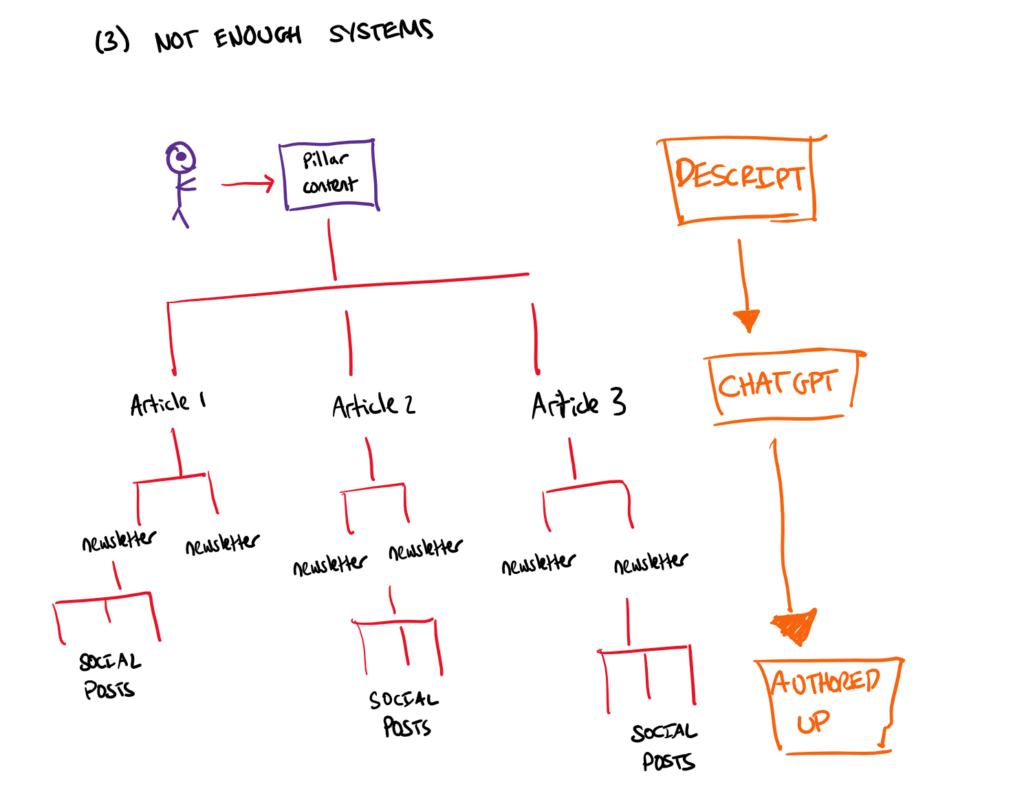
Here’s the problem I see with so many marketing teams: they’re stuck on what I call the “activity hamster wheel.” They’re incredibly busy, constantly reacting to the business’s needs—updating the website, launching ads, prepping for events—but none of these activities are fully mapped to the buying journey.
“We need to make sure that every activity we’re doing drives demand generation forward”.
George Coudounaris – The B2B Playbook
If your work isn’t aligned with driving long-term demand, you’re just spinning your wheels.
That’s where having the right systems comes in. For Kevin and me, the big unlock was building a content repurposing system. Once a week, Kevin and I shoot our pillar piece of content, The B2B Playbook podcast. From that, we get :
- the podcast,
- a 40-minute YouTube episode
- 12 LinkedIn posts
- an in-depth article
- a newsletter
- 8-10 YouTube shorts and TikToks
This allows us to stay consistent across multiple channels without scrambling for content every day. It takes us about five hours per week, but we get a ton of content out of that one system. And that’s the key—it’s not about doing more work; it’s about working smarter.
If you don’t have a system in place, you end up doing a lot of fragmented activities that don’t move the needle. By creating systems that align with your goals, you can ensure that every piece of work contributes to long-term success.
Demand gen is a marathon, not a sprint. You need systems that allow you to consistently show up for your audience without burning out. Get organized, map your activities to the buying journey, and stick with it. That’s how you win in demand generation.
Not Measuring the Right Metrics
One of the biggest mistakes I see with demand generation programs is that teams focus too much on lagging indicators, like leads or revenue. Don’t get me wrong—those are important, but if that’s all you’re measuring, you’re missing half the picture. You need to be looking at the right mix of metrics, and that includes leading indicators.
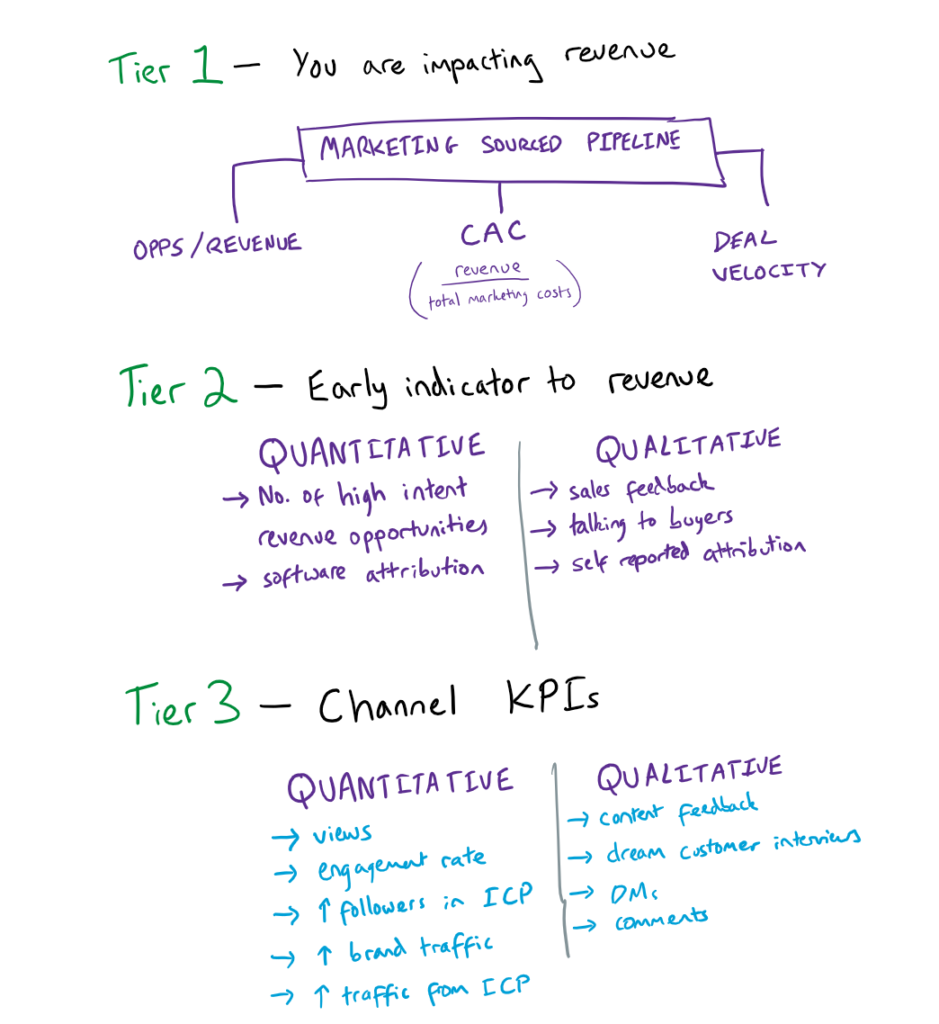
So, what do I mean by leading indicators? These are the early signs that tell you if your demand generation efforts are gaining traction. You need to look for things like:
- Are you getting more brand traffic from your activities?
- Are you getting more traffic from your ICP on your website
- Are your ICP interacting with your LinkedIn ads or your organic content?
These metrics give you a pulse check before the big results come in. If you’re only waiting for leads or sales, you could be missing important signals that your strategy is working.
We also often look at qualitative feedback we get through our “How did you first hear about us” form, or when prospects mention our podcast in sales conversations. These early indicators tell us if we’re on the right track and help us adjust our strategy if we’re not.
Now, that doesn’t mean you completely ignore the big stuff like CRM data and attribution. Your CRM is still critical for tracking which marketing efforts are converting into actual sales or pipeline. But don’t wait until you see revenue to decide if your demand generation program is working. You need to know earlier if you’re heading in the right direction.
Demand gen is about staying on track, before you see that bottom-line revenue. Look at both leading and lagging indicators, so you don’t miss the full picture of what’s working. That way, you can make smarter decisions and keep your demand gen program moving in the right direction.
Misalignment Between Sales and Marketing
If your sales and marketing teams aren’t working together, you’re setting yourself up for failure. Demand generation only works when both teams are aligned and rowing in the same direction.
The problem is, in most businesses, they don’t. Marketing is creating content and running campaigns without understanding the reality of what sales is facing on the ground. And sales? They’re left to clean up the mess, dealing with objections that marketing could’ve addressed but didn’t.
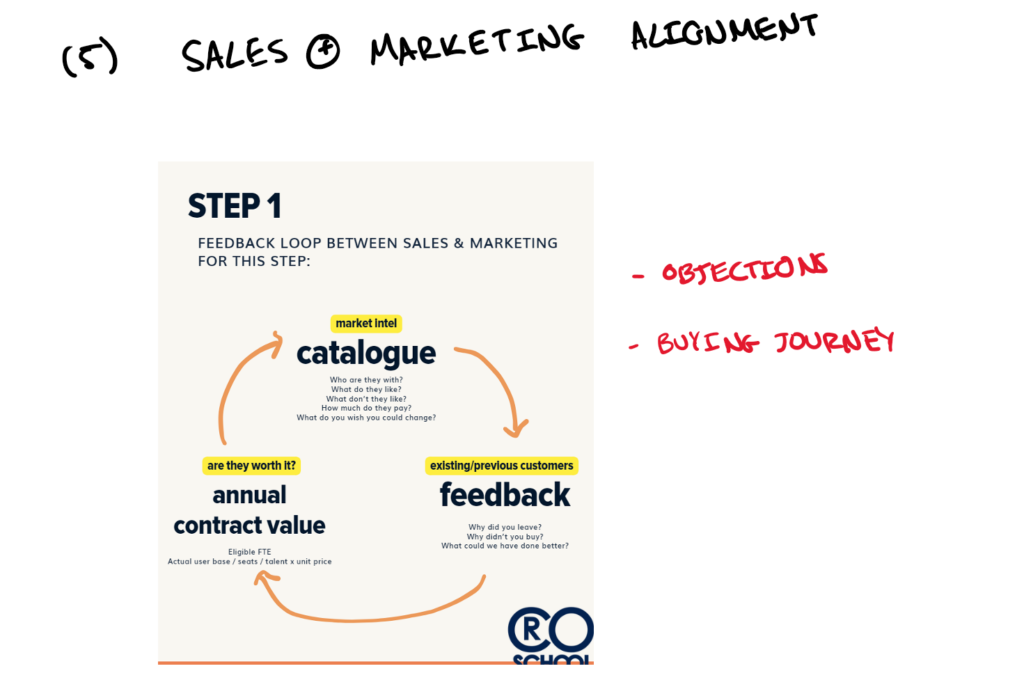
For example, sales might be having conversations with prospects and realize that there are some that have slipped through that are actually not a great fit for your business. If sales doesn’t give that feedback to marketing, then marketing keeps targeting the wrong prospects. It’s wasted effort on both sides, and it’s easily avoidable with better communication.
And it’s not just about ICP targeting.
“Sales might get objections in conversations that marketing hasn’t addressed in their content. And when that happens, marketing hasn’t done its job of pre-emptively answering those questions”
George Coudounaris – The B2B Playbook
This creates friction. When marketing content doesn’t handle these objections upfront, sales teams have to fight an uphill battle to close deals. The whole point of marketing is to set sales up for success—to warm up the prospects so that sales can focus on closing. But if there’s no alignment, that’s just not happening.
Marketing and sales should be working as one team, aligned on messaging and goals, so that prospects are getting a consistent experience whether they’re reading an article, seeing an ad, or talking to a salesperson.
We’ve even built a specific program to help heads of sales, heads of marketing, and chief revenue officers align their teams. It’s called our Chief Revenue School (you can check this out here). Without alignment, you’ll struggle to convert prospects into customers, no matter how good your demand generation is.
Schedule regular check-ins with sales, share feedback, and work together to refine your messaging.
Lack of Patience (Bonus!)
Some businesses have a lot of key elements for their Demand Gen Engine to work, but they’re just not patient enough to let demand generation actually work.
Everyone wants quick wins, but demand generation is a long game. It’s about building awareness, trust, and relationships over time, and that doesn’t happen overnight. We see that it takes on average one and a half to two sales cycles to really see outcomes from demand generation. That’s months, sometimes even longer, before you start seeing real, measurable results.
Now, sometimes you’ll get lucky—you’ll catch a prospect who’s already far along in their buying journey, and you’ll see immediate results. But if you see more immediate results, then you’ve just happened to snag someone who was later on in that buying journey. That’s ‘needle in a haystack’ kind of stuff though. You can’t rely on quick wins. It’s not sustainable, and it’s not how demand gen is supposed to work.
One of the biggest challenges we face as marketers is managing expectations—especially from leadership. Sadly, leadership feels that marketing is an on switch. But we all know that there’s a buying journey, and we are there to influence it. Demand generation isn’t something you can just turn on and expect leads to start flooding in. It takes time. You’re guiding prospects through a journey, and that journey requires multiple touchpoints and consistent engagement.
If you’re not patient, if you don’t give your demand generation strategy the time it needs to mature, you’ll pull the plug before you ever see the results. And that’s where most businesses go wrong. They panic, pivot too quickly, and end up with a scattershot approach that never gains traction.
Final Takeaways and Next Steps
If you want your demand generation program to start delivering real results, here’s what you need to focus on:
- Audit your ICP: Are you targeting the right people? Dive deep into who your ideal customers are and make sure you fully understand their pain points and buying journey.
- Leverage subject matter experts: Ensure your content is driven by real experts who can speak the language of your audience and build trust.
- Implement consistent systems: Create a content production and distribution system that allows you to stay consistent and maximize your efforts.
- Track the right metrics: Don’t just focus on lagging indicators like leads or revenue. Include leading indicators like brand traffic and qualitative feedback to measure progress early.
- Align with sales: Schedule regular check-ins with your sales team and ensure both teams are aligned on messaging, goals, and the target audience.
- Be patient: Understand that demand generation takes time—often one and a half to two sales cycles—so stick with your strategy long enough to see results.
If you’re ready to take your demand generation to the next level, check out our 12 week Demand Generation Course, The B2B Incubator. We’ll help you build a demand gen engine that works for the long haul, giving you the strategy, tools, and systems you need to drive revenue consistently.
